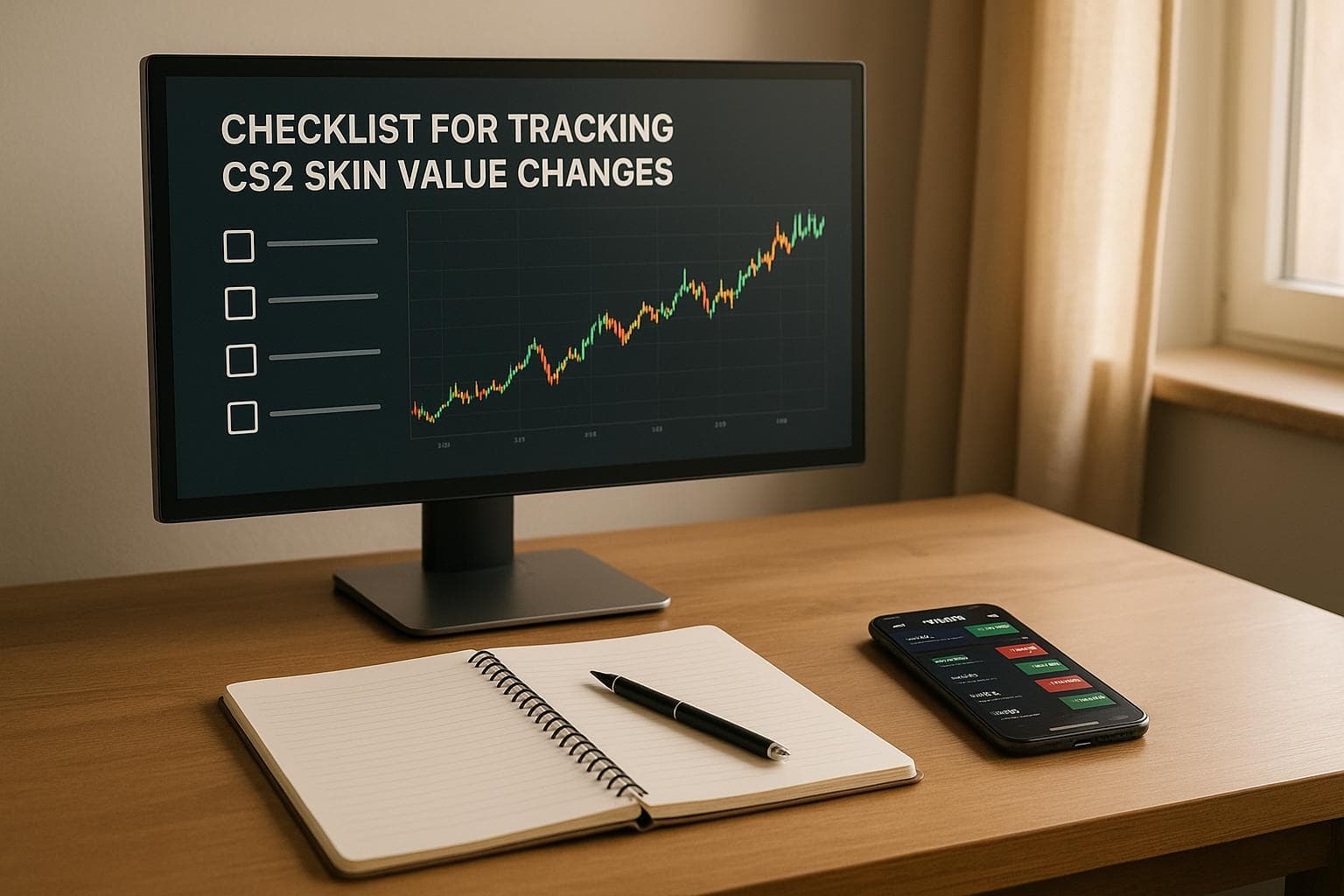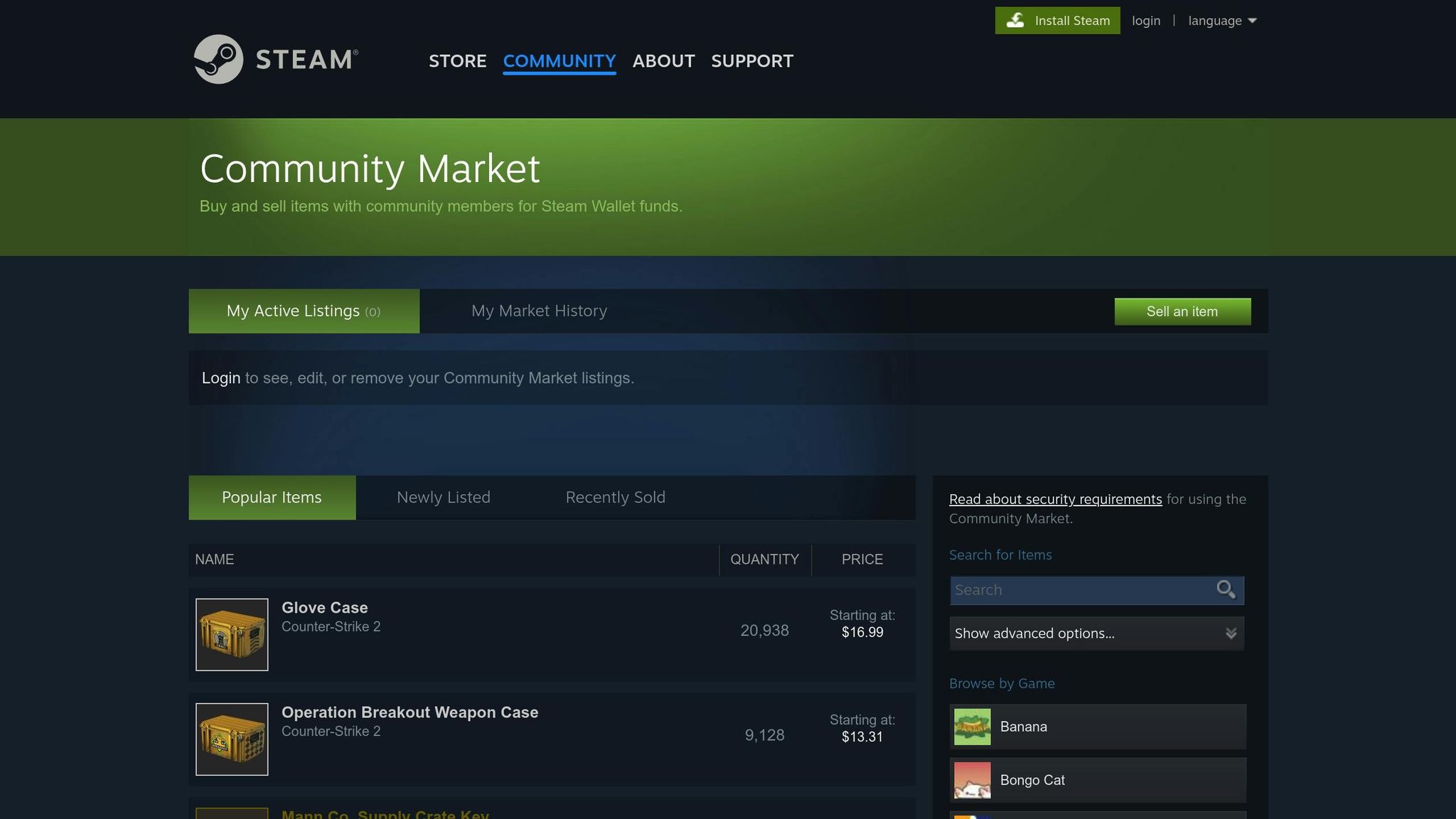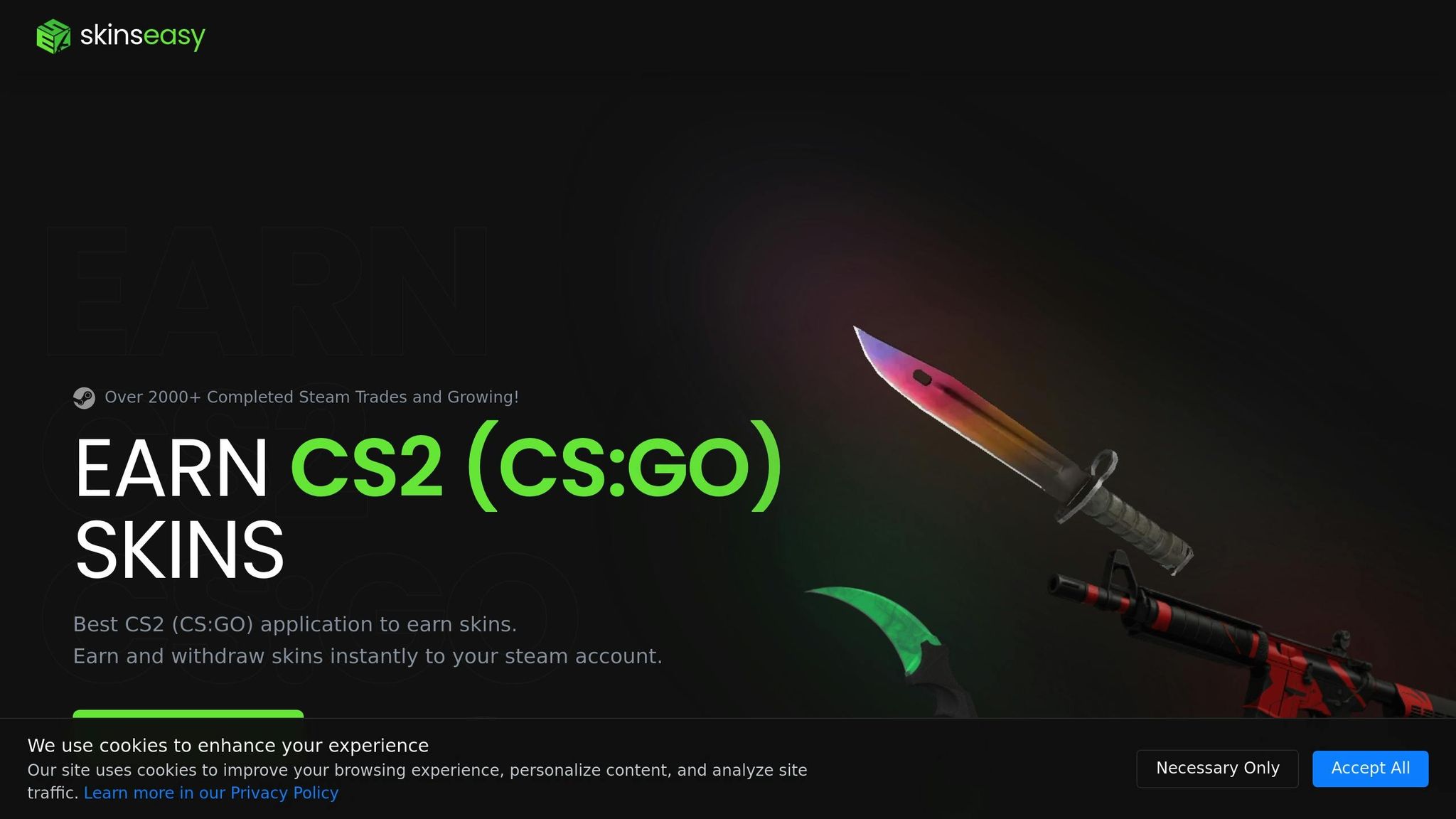Checklist for Tracking CS2 Skin Value Changes

Checklist for Tracking CS2 Skin Value Changes
Tracking CS2 skin values is crucial to navigating a fast-changing market influenced by supply, demand, game updates, and events. By monitoring these shifts, you can make informed decisions about buying, selling, or holding skins to avoid losses and capitalize on opportunities. Factors like float values, rarity, weapon popularity, and special features significantly impact pricing. Tools like the Steam Community Market, CSFloat, and BUFF163 help analyze trends and set price alerts. External events such as game updates, tournaments, and seasonal sales also affect prices. Regularly reviewing your collection and using platforms like SkinsEasy can further enhance your trading strategy. Success lies in consistent tracking, timely decisions, and leveraging the right tools.
Best Free AUTOMATIC CSGO Investment Tracker | CSGO Investing
Key Factors That Change Skin Values
Understanding what drives the price of skins is crucial, as their value shifts based on market conditions and player demand. Here’s a closer look at the main elements that influence skin pricing.
Float Value and Wear Conditions
At the core of skin pricing lies the float value, a number between 0.00 and 1.00 that determines a skin's wear condition. The lower the float, the better the condition - and the higher the price.
Skins fall into five distinct wear categories based on their float range:
- Factory New (0.00–0.07)
- Minimal Wear (0.07–0.15)
- Field-Tested (0.15–0.38)
- Well-Worn (0.38–0.45)
- Battle-Scarred (0.45–1.00)
However, not all skins are available in every wear condition, which can lead to noticeable price differences. Take the AK-47 Redline, for example - it cannot exist in Factory New because its float range starts at 0.10. As a result, Minimal Wear becomes the best possible condition, often priced 3–4 times higher than Field-Tested versions.
Even within the same wear tier, lower float values can make a difference. A Minimal Wear skin with a 0.07 float is typically more expensive than one with a 0.14 float, as it’s closer to Factory New quality. These subtle differences are often leveraged by traders to maximize profit.
Rarity Tiers and Market Demand
Rarity plays a big role in pricing, with CS2 skins divided into six tiers:
- Consumer Grade (white)
- Industrial Grade (light blue)
- Mil-Spec (blue)
- Restricted (purple)
- Classified (pink)
- Covert (red)
Higher rarity levels generally mean higher prices, but demand can sometimes override this hierarchy. For example, the AK-47 Redline, a Mil-Spec skin, often fetches higher prices than some Classified skins due to its popularity and iconic design.
The availability of skins also impacts value. Skins from older, discontinued cases, like the Bravo Case (discontinued in 2013), are particularly sought after. With the Bravo Case now costing over $30.00 to open, its skins have become increasingly valuable.
Weapon popularity further shapes demand. Skins for widely used weapons like the AK-47 and AWP tend to hold their value better than those for less popular guns like the SG 553 or AUG. This means that even lower-tier skins for popular weapons can outperform higher-tier skins for less-used ones.
Special Features and Customization
Certain features and customizations can significantly boost a skin’s value:
- StatTrak™: This feature tracks kills and can raise a skin’s price by 50–200%, depending on the weapon’s popularity and the skin’s base price.
- Rare Patterns: Skins with unique patterns, such as high-blue Case Hardened or full Fade finishes, can be worth 10–50 times more than standard versions.
- Stickers: Applied stickers, especially rare or discontinued ones like the Katowice 2014 iBUYPOWER Holo, can add thousands of dollars to a skin’s value. The impact depends on the sticker’s placement and the skin’s popularity.
- Souvenir Skins: These come with special gold stickers from major tournaments and often command high prices due to their limited availability and connection to specific matches. Player signatures and tournament authenticity make them particularly appealing to collectors.
A combination of these factors - such as a low float, rare pattern, and valuable stickers - can drive a skin’s value to extraordinary levels.
Tools for Tracking Market Trends
To stay ahead in the CS2 skin market, it’s essential to use tools that help you monitor skin values and keep up with rapid market changes. By analyzing data across various platforms, you can fine-tune your timing and make smarter decisions.
Steam Community Market Tracking

The Steam Community Market is your go-to source for real-time pricing data. This platform provides up-to-date prices for all tradeable skins and includes details that other tools often miss.
Start with the price history graph, which covers the last 30 days. This graph helps you identify trends and sudden price changes. Below the graph, you’ll find recent sales data with timestamps and sale prices - perfect for tracking the latest market activity.
Pay attention to the quantity available for each skin. If there’s a scarcity at a particular price point, it could signal an upcoming price increase. On the other hand, a large number of listings at similar prices might indicate market stability or even potential price drops.
Another key metric is volume data, which shows how many items sold in the past 24 hours. High sales volume with rising prices often signals strong demand. Conversely, high volume with falling prices may suggest sellers are eager to offload their inventory.
Third-Party Price Tracking Tools
While Steam offers real-time data, third-party tools provide deeper insights and advanced features to help you analyze the market more effectively. These tools collect data from multiple sources and present it in user-friendly formats, making it easier to spot trends.
- CSFloat Market Checker: This tool provides precise float value analysis alongside pricing data, helping you identify undervalued skins. It also calculates sticker values on weapons - something Steam doesn’t do automatically.
- BUFF163: Known for highlighting price trends and arbitrage opportunities, BUFF163 can reveal price gaps between platforms, which may indicate profitable opportunities.
- SteamAnalyst: This tool offers detailed historical data, including charts with moving averages and volatility indicators. It also tracks case opening statistics, giving you insights into potential supply changes.
Many of these tools also allow you to set up price alerts via email or browser notifications. Alerts ensure you don’t miss critical market movements, even when you’re not actively monitoring the market.
Analyzing Historical Price Data
Looking at historical price data can help you identify patterns and improve your timing. Past trends often reveal how skins react to different market conditions and events.
For example, seasonal patterns are common. Prices often rise during the Steam Summer and Winter Sales, when market activity spikes. On the flip side, prices might dip during periods like the start of the school year, when player activity decreases.
Major tournaments also influence the market. Player signature stickers and team-related items often see increased demand during these events. Similarly, weapon skins used by professional players may experience temporary price surges.
Another factor to consider is price correlations. A price increase in one popular skin can sometimes trigger similar movements in related skins. Recognizing these relationships can help you anticipate changes across your portfolio.
Finally, keep an eye on case discontinuation trends. Skins from discontinued cases often see significant price increases in the months following their removal from circulation. Watching Valve’s case rotation patterns can help you spot investment opportunities early.
When comparing prices, use percentage-based analysis rather than focusing solely on dollar amounts. For instance, a $10 increase has a much greater impact on a low-priced skin than on an expensive one. This approach helps you identify which skins are experiencing the most meaningful relative price changes.
sbb-itb-885d88f
External Events That Impact Skin Values
External events can cause noticeable shifts in CS2 skin prices. While internal market factors play a role, these external occurrences often serve as powerful triggers for value changes.
Game Updates and Patch Changes
When CS2 operations introduce special case collections, the rarity of these items after the event often leads to price increases. This post-operation scarcity is a key factor in the value spikes seen in the market.
Other game updates and patches can also influence the market, adding another layer of unpredictability.
Seasonal Events and Tournaments
Big tournaments like ESL One Katowice and FACEIT London Major often release limited-edition themed skins. These events also drive up the value of team and autograph stickers, making them hot commodities during and after the tournaments.
Seasonal trading is another opportunity for gains. Many players buy skins in anticipation of upcoming events, aiming to benefit from predictable price increases. Purchasing skins before major events, when prices are lower, can be a smart strategy.
Steam's Summer and Winter sales further shake up the market. Discounts during these sales often lead to more case openings, which can increase skin supply. At the same time, the surge in player activity during these periods tends to boost demand.
To make the most of these opportunities, it’s helpful to mark major CS2 dates on your calendar. Incorporating event-based insights into your regular market tracking can give you a competitive edge.
Managing Your Skin Collection
Taking an active role in managing your CS2 skin collection can help you get the most out of your investments. Here’s a practical guide to reviewing, deciding, and expanding your collection.
Setting Up a Review Routine
Make it a habit to review the value of your skins weekly. Compare the current market price of each skin to what you originally paid. Keep track of details like the skin name, purchase date, initial cost, current value, and the percentage change. By analyzing these trends monthly, you’ll gain insight into how your collection is performing.
To save time, consider setting up price alerts for your most valuable skins. These alerts notify you when a skin hits a specific price - whether it’s a high point for selling or a low point for buying - so you can act quickly without constantly monitoring the market.
Deciding When to Hold or Sell
Timing is everything. Hold onto skins when you notice a steady upward trend or in the lead-up to major events that might boost demand. On the flip side, sell during extended market peaks to lock in profits and balance your collection.
Your approach should align with your goals. Long-term collectors may ride out temporary market dips, while active traders should react promptly to shifts in value.
Expanding Your Collection with SkinsEasy

If you’re looking to grow your inventory, SkinsEasy offers a smart alternative to traditional case openings. The platform’s bidding system and task rewards provide opportunities to acquire new skins while staying within your budget.
Consistency is key. Engage daily by completing simple tasks and challenges to earn tokens. Use these tokens to participate in auctions, where you can bid strategically on the skins you want. SkinsEasy’s transparent system ensures fair competition, making it easier to secure items without overspending.
Once you win an auction, SkinsEasy delivers the skins directly to your Steam account quickly and securely. For extra rewards, try features like quiz mode to boost your earnings and keep your collection dynamic and profitable.
Conclusion: Success in the CS2 Skin Market
Success in the CS2 skin market boils down to consistent effort, informed choices, and staying adaptable to changes. As discussed earlier, effective tracking relies on maintaining a steady approach and understanding market dynamics. Pair this with dependable tracking tools, and keep an eye on external factors like game updates and tournaments to stay ahead of market trends.
Regularly assessing the value of your skins and making smart decisions about when to hold or sell can make a huge difference. Tools that provide timely alerts and insights, as mentioned earlier, can make your decisions sharper. While timing the market is important, don’t underestimate the power of patience.
Platforms like SkinsEasy offer a straightforward way to grow your collection without the unpredictability of traditional case openings. By completing daily tasks, playing games, or filling out surveys, you can earn skins quickly and securely, delivered straight to your Steam account. It’s a great option for both newcomers and seasoned traders.
Ultimately, succeeding in the CS2 skin market comes down to applying a mix of strategy and consistency. Whether you’re tracking the value of a rare AK-47 skin or keeping tabs on the latest knife releases, the core principles remain the same. Stay engaged with the community, keep learning, and use the tools at your disposal to make your collection work for you.
The market will keep evolving, but mastering the basics of tracking and managing your collection will give you a lasting edge. Start applying these strategies today, and you’ll be ready to handle whatever changes the CS2 skin market throws your way.
FAQs
How do game updates and tournaments affect the value of CS2 skins?
Game updates and tournaments have a clear impact on the value of CS2 skins. Updates often bring new skins or tweak gameplay mechanics, which can shake up demand and cause prices to swing - sometimes by as much as 67% in just a few days.
Tournaments are another major factor. They boost player engagement and shine a spotlight on certain skins, particularly those linked to well-known teams or players. Seasonal events and sales also play a part, as the surge in activity during these times can heavily influence skin prices.
How can I decide the best time to buy or sell CS2 skins to maximize profits?
To maximize your profits when trading CS2 skins, it’s essential to stay tuned into market trends and updates. Buying skins during market dips, like those that occur after updates temporarily lower prices, can help you snag deals at a discount. Meanwhile, selling during price peaks, often caused by market surges or new updates, can lead to better returns.
Keep an eye on how the community feels about certain skins and watch for upcoming game updates or events that might influence demand. Using market tracking tools and studying price patterns can help you pinpoint the best times to make your moves. Staying informed and ready to act is the secret to successful trading.
What are the best tools for tracking CS2 skin market trends and finding undervalued items?
Tools like CSFloat and BUFF163 can be incredibly helpful for tracking trends in the CS2 skin market and finding items that might be underpriced. CSFloat lets you dig into a skin's float value and check its historical pricing, giving you a clearer picture of its condition and potential value. On the other hand, BUFF163 keeps you updated with real-time price movements and market demand, making it easier to spot opportunities for smart trades or investments.
With these tools, you can keep up with market changes, pinpoint skins gaining traction, and make better-informed decisions when trading.